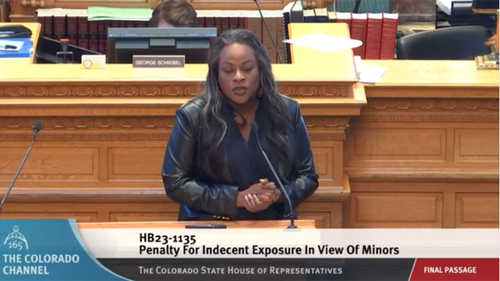Would The Feds Ban Twitter Under The RESTRICT Act?
Authored by Ben Weingarten via RealClear Wire,
Decoupling from Communist China in every strategically significant realm, from the capital markets to defense and pharmaceutical production, and information and communications technology is imperative if we are to counter its hegemonic ambitions and persist as a free and independent nation in something more than name.
Banning TikTok – a ubiquitous social media platform that masquerades as a proliferator of harmless dance videos while doubling as a likely tool of Chinese Communist Party surveillance and data harvesting, and certain tool of its information warfare, under de facto if not de jure CCP control via Beijing-based parent ByteDance – would logically be part of any such decoupling, and manifestly in the U.S. national interest.
But arguably the most prominent congressional effort putatively aimed at achieving a ban of TikTok, the bipartisan RESTRICT Act, raises concerns that the cure may be worse than the disease – to the extent it even ameliorates it.
If past is prologue, key language in the bill hiding in plain sight would seem to legitimize the very heretofore lawless targeting of domestic dissent under which Americans have suffered in recent years – undermining the values and principles the bills’ supporters purport to cherish.
Under the bill, one could easily see the likes of a Twitter, or any other platform or service out of favor with authorities nuked, or at minimum under existential threat.
The RESTRICT Act broadly authorizes the Secretary of Commerce to “review and prohibit certain transactions between persons in the United States and foreign adversaries.”
Among other provisions, it calls on the Secretary to “take action to identify, deter, disrupt, prevent, prohibit, investigate, or otherwise mitigate” any of a number of “undue or unacceptable” national security risks arising from a slew of transactions past or present, including “any acquisition, importation, transfer, installation, dealing in, or use of any information and communications technology product or service” to which entities tied to China or several other countries, or subject to their jurisdiction, have an interest.
The leading co-sponsors of the RESTRICT Act, Virginia Senator Mark Warner, a Democrat, and South Dakota Senator John Thune, a Republican, frame it as “a holistic, rules-based” effort “narrowly tailored to foreign-adversary companies” that is “more likely to withstand judicial scrutiny” than other proposed bills for combatting TikTok – bills that arose in part because the courts stymied President Donald Trump’s efforts to ban the application using existing executive authorities.
Some critics, including China hawks, contend that despite the broad authority the bill grants the Commerce Secretary, it may not ultimately lead to a TikTok ban. The bill does not explicitly call for the banning of the application. Nor does it mention it, or any other application, by name – rather listing broad categories of software and hardware that could be probed under the bill, linked to several foreign foes, including among them China.
Others liken the legislation to the Patriot Act, just for the digital age. This is not meant to be a compliment. They argue that the RESTRICT Act threatens civil liberties – namely free speech – in the name of security by granting the government sweeping powers to crush communication platforms under the guise of ill-defined risks with extensive criminal penalties. The vaguer the language, more pervasive the powers, and fewer the checks and balances, such critics surmise, the riper the opportunity for government to overreach.
While the bill’s backers may argue otherwise, the fears of those left and right who believe the legislation opens the door to censorious mission creep are well-founded. The danger becomes self-evident when one juxtaposes the roots and results of the mass public-private censorship regime imposed upon Americans in recent years, and the bill’s language.
Under said censorship regime, America’s national security apparatus and public health authorities, often government-linked and/or funded academic and research “counter-disinformation” organizations, and Big Tech have colluded to suppress dissenting views from prevailing Ruling Class orthodoxy on a plethora of contentious issues under the guise of public safety and health.
“Digital wrongthink generates real world harm,” the regime argues.
The speech-stiflers have exploited, if not helped fuel a moral panic over mis-, dis-, and mal-information (MDM) – this notwithstanding that such censorious authorities have often proven the most powerful and pervasive propagators of false or misleading information – which they claim threatens American democracy, to justify their actions.
The moral panic has its roots in claims of Russian interference in the 2016 election that proved at minimum highly overblown – with national security authorities framing the threat as primarily a foreign one, which put them on ostensibly stronger footing when it came to their surveilling, policing and/or out-sourcing of policing of speech on social media platforms.
The Capitol riot fanned the flames of the moral panic. Authorities claimed that the greatest threat to the homeland now emanated from, effectively, MAGA terrorists, and that it was dangerous MDM on elections that incited them. Such Wrongthink could incite domestic violent extremists to lash out, including at critical infrastructure, compelling a whole-of-society response.
Authorities, in truth, had already been targeting domestic Wrongthink, particularly on elections, in the run-up to the 2020 presidential contest – operating on the logic that questions about the election process and results represented, or could represent a threat to critical infrastructure including election infrastructure.
The shift in focus from foreign adversaries to domestic Wrongthinkers, and on an ever-growing array of issues, including under an elastic definition of infrastructure, can be seen in the evolution of the Department of Homeland Security’s Cybersecurity and Infrastructure Security Agency, a key cog in the censorship regime.
By the time the COVID-19 pandemic was in full swing, it only made sense that the censorship regime would expand to include policing speech antithetical to whatever authorities believed it imperative for Americans to believe, on matters from the pandemic’s origin, to masking, and vaccine efficacy.
The Biden administration would codify the combatting of domestic MDM, and countering “the influence and impact of dangerous conspiracy theories” in a bid to enhance “faith in government” and “American democracy” as a strategic imperative by way of its June 2021 National Strategy for Countering Domestic Terrorism.
Bear this background in mind – to say nothing of how government has used the most tortured of legal readings to justify its targeting of Wrongthinkers from ex-presidents, to engaged parents, to the pious, running roughshod over the First Amendment in the process – as we look at the language of the RESTRICT Act.
The bill empowers authorities to neutralize risks including those stemming from applications that could: have “catastrophic effects on the security or resilience of the critical infrastructure” of the U.S.; “interfer[e] in…the result or reported result of a Federal election;” or pose a risk of “coercive or criminal activities by a foreign adversary that are designed to undermine democratic processes and institutions or steer policy and regulatory decisions in favor of the strategic objectives of a foreign adversary to the detriment of the national security of the United States.”
Now consider a hypothetical post-RESTRICT Act world.
Imagine there is a U.S.-based social media platform on which Americans are raising questions about and criticizing the RESTRICT Act. At the same time, foreign adversaries, including the PRC, by way of its mouthpieces, are raising the same objections. Might authorities conclude that the proliferation of such ideas could lead to the bill’s repeal, leaving America open to “catastrophic effects on…critical infrastructure” – as evinced by the adversaries’ similar propaganda, one who seek a return to the infrastructure-threatening status quo?
Now, imagine that on that same platform, Americans are posting memes instructing people to vote for U.S. presidential candidates by texting fictitious phone numbers, and that hundreds or even several thousand people might be messaging accordingly. Might authorities conclude the platform is being used to “interfer[e] in…the result…of a Federal election?”
Lastly, imagine Americans are also using this hypothetical platform to raise questions about and criticize America’s continued involvement in the Russo-Ukrainian War. Russian mouthpieces are leveling similar arguments. Russians have been accused of engaging in criminal influence efforts using social media platforms before, including those impacting our politics. Might authorities conclude the platform poses a risk of enabling “criminal activities by a foreign adversary…designed to…steer policy in favor of the strategic objectives of a foreign adversary” by getting Americans to exert political pressure on their leaders to curtail American support for the war?
“But,” one might ask, “why would such a platform fall under the RESTRICT Act if it’s U.S.-based?”
Well, recall that the bill covers any of a slew of transactions in which a foreign adversary or affiliated entity is involved, or to which it is subject to the jurisdiction, “including through an interest in a contract for the provision of the technology or service” in question.
Might the company be targeted on grounds, however tenuous, of having taken a small investment from a person or entity who can be linked to an adversary government, or from a larger fund with ties to an adversary government, or for having used a subcontractor otherwise affiliated in some form or fashion with, or operating under the jurisdiction of an adversary government?
The hypothetical scenario we have conjured up is actually quite real. On Twitter you will find a whole raft of content critical of the RESTRICT Act. On Twitter Douglass Mackey posted the kind of meme described – one for which he was convicted of a federal crime and faces up to 10 years in prison. On Twitter, you will find many critics of U.S. involvement in the Russo-Ukrainian War – a platform that Russians used to allegedly “commit federal crimes while seeking to interfere in the United States political system” during the 2016 election.
What of Twitter’s ties to foreign adversaries? Well, among the co-investors in Elon Musk’s take private of Twitter is cryptocurrency exchange Binance, a company initially based in China, which put up $500 million in equity. Who knows, perhaps there are other links that could be found between Twitter and China, for example via a contractor or subcontractor with which it works or has worked. And this is to say nothing of Musks’s more significant exposure to China by way of Tesla.
The Biden administration, which has seemingly had Musk in its sights since he became interested in purchasing Twitter, and certainly post-acquisition and the release of the Twitter Files, reportedly will not be investigating Musk’s Twitter purchase under existing authorities via the Committee on Foreign Investment in the United States. Might that change under a RESTRICT Act that the White House has championed – this despite its disavowal of the idea that it wishes to decouple from China, and Democrats’ embrace of TikTok as a platform?
If this scenario sounds far-fetched, you are not being nearly imaginative nor cynical enough in this era of sophistry and illiberalism.
America should ban TikTok, but the means must not do more damage than the ends do good.
The prudent and judicious move would be for Congress to take a second look at any of several more tightly-written and straightforward bills aimed squarely at combatting TikTok – that is, if it is really serious about combatting the CCP, rather than granting authorities power-hungry presidents might use to emulate the CCP in silencing domestic opponents.
Tyler Durden
Mon, 05/01/2023 – 23:20
via ZeroHedge News https://ift.tt/DHiM569 Tyler Durden










